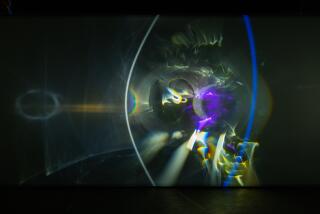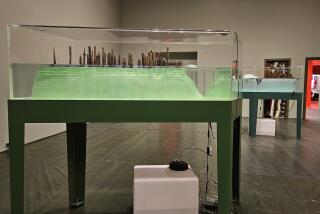ART REVIEW : Cage’s ‘Circus’ a Three-Ring Sensual Blast : His Witty Study in Organized Chaos Is a Sight to Be Heard
- Share via
The late John Cage, who died last year at the age of 80, brought to the consideration of 20th-Century aesthetics a seriously playful regard for the modern, pervasive wonders of organized chaos.
And “Rolywholyover A Circus” is precisely that. In fact, it’s a three-ring circus.
In this exceptional exhibition at the Museum of Contemporary Art, each of three progressively larger galleries is the site for a different act, all of which carry on simultaneously. The show, on which the Los Angeles native had been working at the time of his death, is eccentric, highly refined and thoroughly enjoyable in its deft elucidation of Cage’s artistic philosophy. Each ring of the circus has something specific to say, and it says it with wit and elan.
The odd double-spacing and absence of punctuation in the title, “Rolywholyover A Circus,” is one key to the show’s sense of musicality. Cage was perhaps the leading avant-garde composer in America, and he approached “Rolywholyover” (the twirling word comes from James Joyce’s landmark novel “Finnegan’s Wake”) as a musical composition in which artifacts and works of art would be like individual notes deployed in a larger concert. You read the title’s words in a specific way, with the unusual spacing placing subtle emphasis on the interval of silence between sounds.
With Cage, every detail, however seemingly insignificant, is sharply considered. The first gallery is a kind of archive, framing the modern idea of a museum, which is where the show takes place. Four cupboards, vaguely reminiscent of old apothecary shelves, hold books, records and musical scores of importance to him.
Deployed around the room are artifacts borrowed from 22 museums of all kinds (art, science, kitsch, etc.) located within a 30-mile radius of MOCA. Everything from a bronze sculpture to a carved seed, from manhole covers to Ingrid Bergman’s bustier, takes its place in the acquisitive space of modern collecting institutions.
In the center of the room, trestle tables and chairs provide a place to sit and read, to watch leaves drop from the potted trees clustered at one side or to play chess. The fusion of mathematics and intuition in the cerebral war game is a touchstone for Cage’s aesthetic, while declaring significant roots in the art of Marcel Duchamp.
The second gallery is at once the most revealing, demonstrating the union of tradition and radicalism that Cage embraced, and the least appealing. Visually it’s dull, conceptually it’s rich.
Its walls hold framed scores and graphic works by the composer, whose gifts as a visual artist were decidedly thin. Cage’s prints and watercolors, mostly dating from the 1970s and 1980s, employ pale washes of fluid color and gentle, abstract lines, circles and other markings.
The airy, open manner of these graphics, which recall early Mark Rothko and others of the New York School in the 1940s and 1950s, might best be described as American Abstract Expressionism as executed by a traditional Japanese brush painter. What’s revealing is their intimacy and quietude.
In a most unusual way, they seem to be more about listening to visual marks made on a page than they are about the conventional activity of looking at those marks. Like the more typical musical compositions with which they are interspersed, Cage’s watercolors and prints turn out to be written and printed scores, albeit for music played exclusively in your eyes.
There’s not much art in this second gallery, but there is something important to see. Resting in a vitrine that is the central axis for everything else in the room, an autographic manuscript by the great 19th-Century naturalist and philosopher Henry David Thoreau is opened to a page that, in addition to his nearly illegible script, shows a drawing of a feather--a drawing that also turns up nearby in a Cage print.
Between Thoreau’s careful musings on his vegetable garden at Walden Pond and his brilliant articulation of the moral authority of civil disobedience, the writer as a radical democrat stands as a virtual signpost for museum visitors. It prepares you to enter the final and largest arena of Cage’s compelling circus.
Talk about radical democracy! On display in the next room is a vigorous ode to social equality and individual independence that breaks museum rules.
This third gallery includes about 150 works by artists personally significant to Cage. The gamut runs from Ellsworth Kelly to Ellsworth Snyder, with neither the celebrated nor the obscure ranked in a hierarchy.
At one end of the big room, open storage racks hold works of art that may--or may not--be brought out for display in the gallery. Two interactive computer stations allow visitors to craft poetry and music.
Overall, the display works like this: A conceptual grid has been laid over three walls and the floor of the gallery; numbered works of art are assigned to positions on the grid, according to a computerized score that incorporates random instructions derived from the Chinese I Ching. This being a musical composition, the arrangement is constantly changing. Museum staffers follow the score, rearranging works in the gallery during the museum’s public hours.
The accumulated alterations can be stark. On my first visit, objects were pretty evenly distributed throughout the room. On my second, six days later, objects were bunched up in one half of the gallery, while the other was sparse. (MOCA, by the way, is offering a multiple-visit ticket for those who want to return.) Logically, the dispersal of objects shapes the dispersal of viewers in the room, linking one to the other in a visible way.
None of the art is labeled. Your eyes must read the paintings, not the names or titles. Visitors can pick up a numbered reference key at the museum entrance, against which works of art can be checked. But the priority has been subtly--and effectively--established: perception first, cognition second.
Remarkably, the works of art become a catalogue illuminating Cage’s aesthetic philosophy. As you scan the big room, certain unsurprising generalizations can be made about the composer’s taste.
Spatial abstractions prevail, from Mondrian and Malevich to Fanny Schoening and Dove Bradshaw. Mapping is frequently encountered, but figures aren’t (except in camera works). Earth tones and sky blue are the colors that predominate. And some of the art is great, some awful.
More important, though, is the larger scenario Cage establishes. This buoyantly engaging show lets you feel and experience your relative place in the cosmos--at once minuscule, a speck, a humble bit of dust somewhere on a grid among countless others, as well as a moving center of consciousness, poised to be stunned, amused, appalled and delighted by your ever-changing position. In a century notable for global cataclysms, genocidal holocausts and the capacity for total annihilation, this significant bit of experiential wisdom is not a mean artistic achievement.
Organized by MOCA curator Julie Lazar, and featuring an unusual catalogue composed of pictures, bits of printed paper and smartly written brochures housed in an elegant, highly polished aluminum box, in which the world is brightly mirrored, “Rolywholyover A Circus” may be the definitive Cage exhibition. Go hear it.
* Museum of Contemporary Art, 250 S. Grand Ave., (800) 662-2937, through Nov. 28. Closed Monday.
More to Read
The biggest entertainment stories
Get our big stories about Hollywood, film, television, music, arts, culture and more right in your inbox as soon as they publish.
You may occasionally receive promotional content from the Los Angeles Times.











